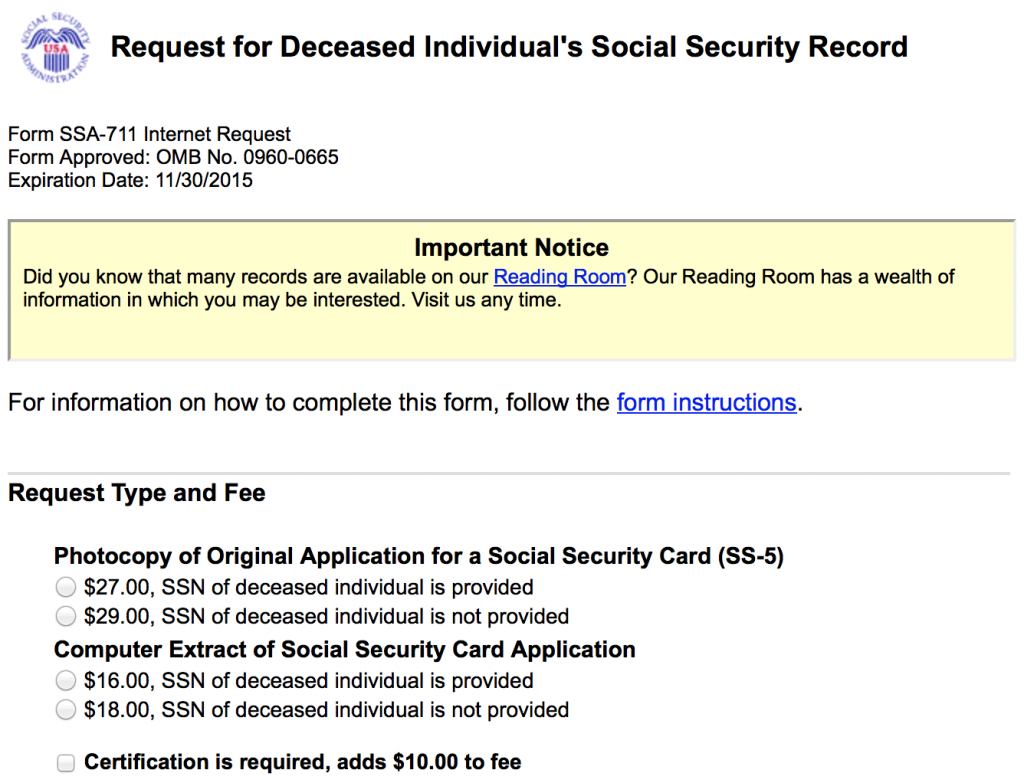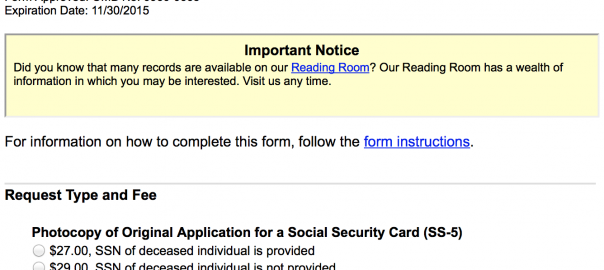Recently I was asked about ordering a copy of an ancestor’s Social Security application. The application, called an SS-5 Form, is usually used for genealogy to get the names of the applicant’s parents. If you don’t know the birth date of a relative, it can also be used for that purpose, although that information is available in the public SSDI databases (and parents names are not).
The SSDI
The Social Security Death Index (SSDI) is a database of deaths recorded by the Social Security Administration. It’s official name is actually the Death Master File (DMF). When published online for genealogy purposes it is referred to as the SSDI. According to FamilySearch, the SSDI includes an increasing percentage of recorded deaths as time goes on from 1962 (when the index started):
The index includes about 50 percent of deceased persons from 1962 to 1971 and about 85 percent of the deceased persons from 1972 to 2005. It also includes a few deaths from 1937 to 1961.
That said, the database itself shows something a bit different. If you search for all deaths in the database from 1937 to 1961, there are 740,152 results. That’s a bit more than ‘a few’. What’s going on here? Even weirder, if you search for records before 1937 (when SS started) there are also records (a bit over 2500). Something is obviously wrong with these records. Keep these imperfections in mind when using the data. If you’re wondering why the percentage increases, it’s because not every working person was registered in the early days of the system. As time went on, more people participated in social security, and thus more people are also recorded in the SSDI.
So assuming your relative is among those recorded in the SSDI, how do you find their record, and assuming you find it, how do you get the record? One thing first…
Restrictions on Usage
You might have read that congress has criticized the online publication of social security numbers and accused online companies that do so of making identity theft easier. I have argued in the past that in fact that is backwards, but putting that aside, some online services have put restrictions on access to SSDI data, such as not showing anyone who died in the past 10 years, etc. Recently a law was passed making it impossible to order SS-5 Forms for anyone who died in the previous 3 years. The law also effects the publication of new deaths to the SSDI, but won’t kick in until March (see this article at the Legal Genealogist for more information on that).
Whether 3 or 10 years, however, that doesn’t affect genealogists at all due to another government policy change. Back in 2011, the Social Security administration changed the access rules, where before you could order a complete SS-5 form for any deceased person born more than 70 years ago, they increased it to anyone born more than 100 years ago. Additionally, if the death of the application cannot be proved, then full records are not available for 120 years after the applicant’s birth.
So it’s currently January 8, 2014. That means if the person is known to be dead (i.e. you have a death certificate, or their death is recorded in the SSDI) then they need to have been born before January 8, 1914 if you’re going to be able to get a full record that shows the applicant’s parent’s names. If they don’t show up in the SSDI and you don’t have a record of their death (but you do have a social security number), then they have to have been born before January 8, 1894 if you want to get the applicant’s parents names.
Don’t Order Records That Won’t Help
Keep in mind one important thing. If the person was born more recently than 100 years ago, you can still order a copy of the SS-5. The Social Security Administration will happily take your money and send you a copy of the record, however, they will block out the names of the parents in the copy they send you (making the record mostly useless for genealogical purposes).
Searching the SSDI
To find a person’s social security number (and at the same time confirm that they are deceased according the Social Security Administration) you can search the SSDI on several sites. One good site is FamilySearch’s SSDI search page. Another public search page is Mocavo’s SSDI Search page. I will say that I believe FamilySearch’s to be the most up-to-date database, and they also post what date the database was updated – as of today it was updated with data up to November 30, 2013 – less than two months ago. Indeed my grandfather who passed away in September is listed in the FamilySearch database, but not in the Mocavo one.
Ordering Records
So let’s say the relative you’re researching was born more than a hundred years ago. You find their Social Security number, either through the SSDI or through other means. How do you order a record? Well that’s actually easy. You just go to the Request for Deceased Individual’s Social Security Record page, pay your $27 and order the record.

Interestingly for two dollars more you can order the record even without the Social Security number. This is odd because searching for the record without the number would seem much more difficult and more costly than $2.
A Final Thought on the Restrictions
As I mentioned, my grandfather passed away in September. If I wanted to order his SS-5 form, according to the 2011 regulations I wouldn’t be able to order his un-redacted SS-5 form until he would have been 100, which in his case is not too far away – he was 98 – so July 2015. However, because of the new law recently passed, I can’t order the SS-5 at all until 3 years have passed, so September 2016. An extra year and a bit. In general, however, the restriction is likely to be on the 100-year regulation.
Everyone now needs to wait 3 years on ordering an SS-5 now, but if a relative passed away at the age of 80, you’d have to wait 20 years before you could get the un-redacted SS-5 form with the name of the relative’s parents on it. If your relative died before 2011 and you had ordered the records before the regulatory change then, you could have ordered the same SS-5 Form immediately, and received it un-redacted (since the relative was over 70).

I saw a reference to your post on Genea-Musings, best of post. Thank you for the concise listing of what is and is not available.
Diane